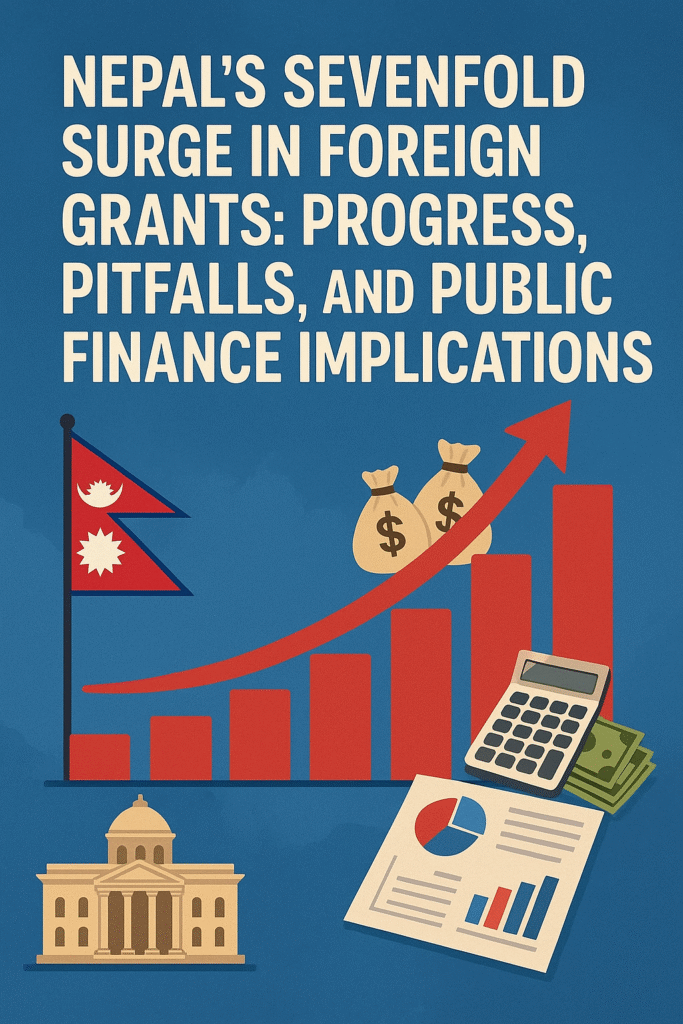
Nepal’s recent sevenfold increase in foreign grant inflows—from Rs. 2.75 billion to Rs. 14.4 billion in the current fiscal year—signals a dramatic shift in international financial support. While this surge reflects improved donor confidence and strategic development partnerships, the figures warrant closer scrutiny. Despite the apparent progress, the inflows represent only 27% of the government’s annual target of Rs. 52.32 billion, underscoring persistent challenges in aligning donor commitments with Nepal’s fiscal priorities.
The staggering year-on-year growth, undeniably a positive marker, highlights the critical role of foreign grants in funding infrastructure, healthcare, education, and climate resilience initiatives for Nepal’s resource-constrained economy. Notably, Rs. 11.81 billion arrived in a single day (Chaitra 31, April 12, 2025), likely reflecting concentrated disbursements tied to high-priority projects or delayed multi-year agreements. While this influx offers temporary fiscal relief by easing pressure on domestic revenue mobilization and borrowing, the timing raises concerns. Late-year inflows risk underutilization, given Nepal’s historical struggles with bureaucratic delays and sluggish project implementation, potentially undermining the urgency of addressing systemic inefficiencies.
The stark gap between the Rs. 14.4 billion received and the Rs. 52.32 billion target reveals deeper systemic issues. Donor disbursements often hinge on stringent conditionalities, governance benchmarks, or project-specific milestones that Nepal’s institutions struggle to meet consistently. Geopolitical shifts, such as aid reallocations due to global conflicts or economic crises, further disrupt pledged amounts. The ambitious target may also reflect over-optimism in negotiations or a misalignment between donor priorities and Nepal’s absorptive capacity, particularly in sectors like rural infrastructure or administrative reforms that lack donor appeal despite their developmental urgency.
The immediate benefits of increased grants—reduced reliance on debt and supplemental budgets—are tempered by long-term risks. While grants avoid future repayment burdens, their volatility complicates fiscal planning. A single-day windfall, for instance, inflates annual figures without guaranteeing sustained support. Moreover, project-tied grants risk distorting local priorities, sidelining critical needs in favor of donor-preferred sectors. Nepal’s public financial management systems, historically plagued by mismanagement and corruption in aid-funded projects, face heightened scrutiny. Without robust oversight, the current surge could exacerbate inefficiencies, eroding both development outcomes and donor trust.
Geopolitical dynamics further complicate the landscape. Nepal’s strategic position between India and China makes it a focal point for donor influence. Traditional partners like the World Bank and Asian Development Bank, alongside newer players like China through its Belt and Road Initiative, may be engaging in competitive generosity. While donor diversification is beneficial, overreliance on geopolitical rivals risks entanglements in conditional agreements or debt-trap diplomacy, potentially compromising sovereignty.
To sustainably leverage this surge, Nepal must address structural weaknesses. Strengthening project implementation capacity, enhancing transparency, and aligning grant utilization with national development goals are imperative. Diversifying funding sources, improving tax compliance to boost domestic revenue, and negotiating flexible grant terms could mitigate over-dependence. While the sevenfold increase is commendable, it is not a panacea. Nepal’s public finance trajectory hinges on translating short-term inflows into long-term gains through accountability, strategic planning, and institutional reform. The true measure of success lies not in celebrating numerical growth but in ensuring equitable, impactful development that uplifts all segments of society.
This article was published on Publicfinance.pk
Source: Nepalnews.com
